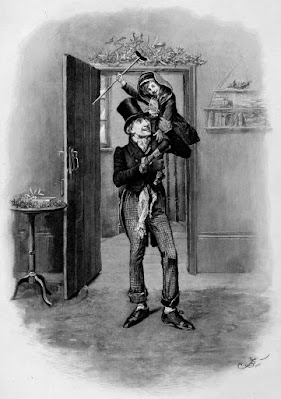Welcome to my latest blog post. As you may know, I am currently working my way through a series on beliefs surrounding disability. After a couple of weeks focusing on the festive season, I will now continue from where I left off with Bes. This week I will be discussing the concept of the evil eye. While it spans both time and space, I will be mainly focusing on the ancient Greeks and Romans. I occasionally find myself wondering what it would be like to live back then, but then I remember I’m disabled and quickly move on.
What is the Evil Eye?
I suppose the best place to start is to explain what the evil eye actually is. It is a look which one person can give which can harm a person or object. Some people may think that this is nonsense, and nobody can cause harm with their eyes. However, it is still a widely held belief in many parts of the world. The victims of these attacks usually have something which the perpetrator is envious of. This could be good looks, wealth, or good health. The damage caused by such attacks can vary in severity and can cause symptoms such as excessive yawning, hiccups, vomiting and fever, oh…. and in severe cases, death. The object of the evil eye’s attention is not always human. A cow could have it’s milk dry up, whilst a plant could wither and die. Sounds like witchcraft to me!
The Greek philosopher, Plutarch tried to come up with an explanation as to how the evil eye was
cast. He spoke of ‘effluences from bodies’ such as ‘odour, voice, and
breathing’ that can create a stream of particles which produce sensation
whenever they impact our sensory organs. So, in a way, Plutarch thought
that humans are like superheroes that can shoot beams out of their eyes.
However, he did not think everybody had this capability. He suggested
that living creatures were much better at emitting such particles than
inanimate objects as motion and warmth were the key driving forces. It
therefore makes sense that people from warmer regions of the planet
would be more adept at using the evil eye.
One of the driving forces behind the evil eye was envy. This is probably why it is known as the Evil Eye of Envy. However, where did this envy come from in the ancient Mediterranean world? Bruce J. Malina states that there was a belief that there was a limited number of goods in the world, such as wealth, love, honour and manliness. This meant that those without them became envious of those with the goods. Hence, why there was all the superhero business with particles streaming out of people’s eyes.
The Eyes Have It
Human eyes are believed to have special capabilities as they are thought to be the gateway to the soul. People with eye conditions such as twitches, spasms, cross-eyes or squinting eyes can be thought to convey evil or bad luck. Therefore, they are shunned from society. Eyes which are different colours also have the same effect. As the Greeks and Romans mostly had brown eyes, they were wary of people with blue eyes from the east.
This is best seen in the Argonautica, one of the versions of the Jason and the Argonauts story. Jason was returning to Greece with a woman named Medea who he had picked up at Colchis on the Black Sea. On their way past Crete, they were attacked by Talos, a giant man crafted from bronze by the gods to protect the island. He did this by hurling rocks at approaching ships. For some reason, I always picture a giant C-3PO from Star Wars when I think of Talos.
Anyway, Talos was no match for the powers which Medea possessed. She adopted ‘a mind bent on harm’ and ‘bewitched bronze Talos’ eyes with her hate-filled stares. She gnashed her teeth in bitter anger against him and sent forth destructive phantoms with vehement hatred’, destroying Talos in the process. She did this all from a distance while standing aboard Jason’s ship. All I can say is beware of angry women and don’t make eye contact with them whatever you do!
To keep up to date with my latest blog posts, you can like my Facebook page, or follow me on Twitter. You can find them by clicking the relevant icons in the sidebar.
As you can see, ancient civilisations took the evil eye very seriously. Next week I will tell you how they tried to combat it.
The Wheelchair Historian
Further Reading
Apollonius of Rhodes, Argonautica, Edited and translated by William H. Race (January 2009).
Hargitai, Quinn, ‘The strange power of the ‘evil eye’’, 19th February 2018, https://www.bbc.com/culture/article/20180216-the-strange-power-of-the-evil-eye Accessed: 8 January 2021.
Malina, Bruce J., 2001. The New Testament World: Insights from Cultural Anthropology, (Westminster John Knox Press).
Plutarch, ‘Moralia, Table-talk’ in Plutarch Moralia Volume VIII, Books 1-6, Translated by P. A. Clement and H. B. Hoffleit (January 1969).
Radford, Benjamin, ‘The Evil Eye: A Closer Look’, July 28, 2017, https://www.livescience.com/40633-evil-eye.html Accessed: 8 January 2021.
Smith, Elaine, ‘Beware the Evil Eye. Or Buy One, Just for Kicks’, Dec. 6, 2019, https://www.nytimes.com/2019/12/06/fashion/jewelry-evil-eye-greece-turkey-israel.html Accessed: 8 January 2021.
The Editors of Encyclopaedia Britannica, ‘Evil eye’, Encyclopædia Britannica, Date Published: May 17, 2013, https://www.britannica.com/topic/evil-eye Access Date: December 21, 2020.


